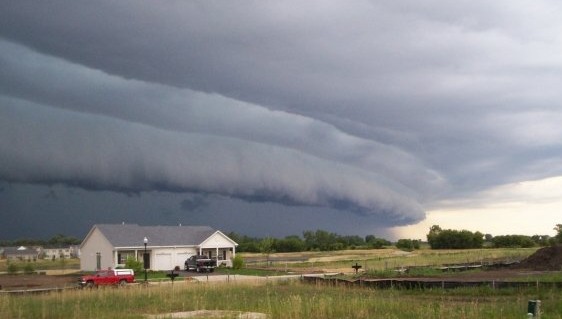Derecho
On Friday night, I was deep into some writing at my computer in the study upstairs. At about 11.15 PM I was pulled from my concentration by the most unearthly sound. It was a roaring unlike anything I had ever heard. A few seconds later the house shook to its foundations with the impact of a colossal wind that flung itself against the building. The shutters strained against their hinges, the windows rattled violently and the whole house was enveloped in the grip of the wind. After about half a minute, it abated. Then the same thing happened—the roar, the impact and the grip of the violent wind. It happened a third time, and then the power went out.I sat in the dark, quite stunned. I was roused from my state of semi-shock by the plaintive complaining of Sasha-the-cat, who had come upstairs and was demanding an explanation for this untoward event. I was as bemused as she was. I belatedly unplugged and switched off my computer, groped by way downstairs to get a torch and made my way to bed. There didn't seem to be anything else I could do in the circumstances. I just lay there, listening to the thunderstorm, which seemed quite mild by comparison.I've now discovered that we were hit by what they call a "derecho". The National Oceanic and Atmospheric Administration (NOAA) defines a derecho this way:
A derecho is a widespread, long-lived wind storm that is associated with a band of rapidly moving showers or thunderstorms. Although a derecho can produce destruction similar to that of tornadoes, the damage typically is directed in one direction along a relatively straight swath. As a result, the term "straight-line wind damage" sometimes is used to describe derecho damage. By definition, if the wind damage swath extends more than 240 miles (about 400 kilometers) and includes wind gusts of at least 58 mph (93 km/h) or greater along most of its length, then the event may be classified as a derecho.
This is a photograph of the gust front "arcus" cloud on the leading edge of a derecho-producing storm system. Photograph by Brittney Misialek, former WGN Weather InternWe are amongst the lucky ones because power was restored after a day and a half, but three million people were without power at the worst peak, and there has been some devastating damage and loss of life. A walk around our lovely Homeland neighborhood showed this.
Photograph by Brittney Misialek, former WGN Weather InternWe are amongst the lucky ones because power was restored after a day and a half, but three million people were without power at the worst peak, and there has been some devastating damage and loss of life. A walk around our lovely Homeland neighborhood showed this. Apparently the gusts of our storm were between 60 and 80 m.p.h. and it is the most severe storm of its kind ever to hit the region. It's more of the extreme weather that points to the clear evidence of the effects of global warming.
Apparently the gusts of our storm were between 60 and 80 m.p.h. and it is the most severe storm of its kind ever to hit the region. It's more of the extreme weather that points to the clear evidence of the effects of global warming.
